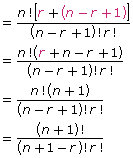Module 8: Lesson 3
Self-Check 5
Questions 7, 8, 12, 18, and 20 from pages 534 and 535 of the textbook
-
-
There are three distinct cases.
Case 1: all possible 1-digit numbers
Case 2: all possible 2-digit numbers
Case 3: all possible 3-digit numbers
-
There are five distinct cases.
Case 1: four students from Grade 12 for the main team and one spare from Grade 11
Case 2: three students from Grade 12 and one from Grade 11 for the main team and one spare from Grade 11
Case 3: two students from Grade 12 and two from Grade 11 for the main team and one spare from Grade 11
Case 4: one student from Grade 12 and three from Grade 11 for the main team and one spare from Grade 11
Case 2: no students from Grade 12 and four from Grade 11 for the main team and one spare from Grade 11
-
- This question will be solved by splitting the equation up into the left side and the right side and then finding that both sides are equivalent.
LS RS 

Because of the multiplicative identity, the denominators on both sides are equivalent. Thus, the left side is equivalent to the right side and 11C3 = 11C8.
-
For nCr−1 + nCr = n+1Cr, the left side will be manipulated first.

Combine the two terms by finding the lowest common denominator.
Notice that (n − r + 1)! = (n − r + 1)(n − r)! and r! = r(r − 1)! In this case the lowest common denominator is (n − r + 1)!r!

Factor the numerator and subtract like terms.

You can now see the left side is equivalent to n+1Cr.
If needed, you can also manipulate the right side to ensure both sides are the same.

Thus, the left side is equivalent to the right side.
-
- For this question there are no restrictions, so any five cards out of the 52-card deck could be chosen: 52C5 = 2 598 960.
- For this question, three of the cards must be hearts (there are 13 hearts in the deck) and the other two cards must be some other suit (the other 39 cards):

- For this question, one card must be black (there are 26 black cards in the deck) and the other four cards must be red (there are 26 red cards in the deck):

- For this question there are no restrictions, so any five cards out of the 52-card deck could be chosen: 52C5 = 2 598 960.
-
- This is a combination question of the form 40C20. This can be represented as follows:

- Because the paintings are being placed in a row now, their order matters. The number of possible choices for the first painting is 20, for the second painting 19, 18 for the third, and 17 for the fourth painting. Thus, 20 ×19 × 18 × 17 = 116 280.
- This is a combination question of the form 40C20. This can be represented as follows:
© 2012 Alberta Education